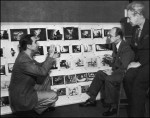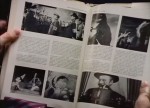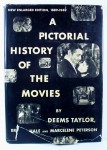Some time ago, I watched a documentary called A Personal Journey with Martin Scorsese Through American Movies. The title says it all, really. It’s about the movies that influenced Scorsese to become a director, the ones he loved as a boy, the ones that shaped his understanding of film. Since he’s a huge, huge movie nerd, he covers an enormous amount of ground, including pictures that are largely forgotten today. It’s the kind of thing you take notes on in the hope you might get a chance to see some of these films one day.
The documentary opens with a scene from The Bad and the Beautiful, a 1952 movie about movies starring Kirk Douglas, Lana Turner, and my secret favorite Dick Powell, in which Kirk Douglas’ producer character argues with the director about how to shoot a scene. At the 3:00 mark, Scorsese appears for the first time, sitting in a chair facing the camera. He’s holding a book. He starts talking:
I guess I have to say that when I was growing up in the 40s and 50s, I spent a lot of time in movie theaters. I became obsessed with movies. At that time there was nothing really available that I could find written on film except one book, sort of my first film book, although I couldn’t really afford to buy it and I couldn’t find a copy except the only one available from the New York Public Library. I borrowed it from the library repeatedly. It’s called A Pictorial History of the Movies by Deems Taylor, and it was a pictorial history of the movies in black and white stills, year by year, up to 1949.
The book cast a spell on me, ’cause back then I hadn’t seen many of the films shown here in the book, so all I had at my disposal to experience these films were these black and white stills. I’d fantasize about them and they’d play into my dreams and I was so tempted to steal some of these pictures from the book. It’s a terrible urge. After all, it’s a book from the public library. Well, I confess: once or twice I did give in to that urge.
[youtube=http://youtu.be/w0yuKp55cuw?list=PL7K7UEvDonQ0Y_f0jnBNZMo43KYjXz5lP&w=430]
This was in an era before the proliferation of university film schools, when the industry was still new enough that taking a scholarly approach to its history seemed incongruous. In fact, when this book was first published in 1943, there was exactly one film school in the entire world: the Gerasimov Institute of Cinematography in Moscow, founded in 1919 by director Vladimir Gardin. The next one, the Film and TV School of the Academy of Performing Arts in Prague, was founded in 1946, three years after the first edition of A Pictorial History of the Movies was published. The United States didn’t get a dedicated film school until 1969 when the American Film Institute‘s Conservatory was established.
Scorsese beat the AFI to the punch, graduating with a master’s degree in film from the Graduate Film program of New York University’s School of the Arts (today the Tisch School of the Arts) in 1966, the year after the program was founded and the year that the author of the book that had ensorceled baby Martin Scorsese to deface it died.
Deems Taylor was a well-known composer, commentator and music critic. Born in 1885, like Scorsese, he too was a graduate of NYU who had made a name for himself as a composer of cantatas in the late nineteenteens. He had great success with two operas he composed for the Metropolitan Opera — The King’s Henchman (1927) and Peter Ibbetson (1929) — now all but forgotten. He was a member of the famed Algonquin Roundtable, the New York literati who gathered to skewer each other over lunch at the Algonquin Hotel, and dated the sharpest skewer of them all, Dorothy Parker, for a short time.
 While Taylor’s compositions and critiques languish in obscurity today, he was nationally famous in his day. He was on the cover of Time magazine in 1931. He was a pitchman for California wines in 1940, his elegance and erudition lending much-needed panache to an American viticulture industry that had been nearly destroyed by Prohibition. Only fortified desert wines like sherry sold well in the United States (you can see that referenced in the ad) but it wasn’t because they paired well with roasts; it’s because they were taxed at a lower rate than hard liquors but had 20% alcohol so they provided the best bang for one’s buck. Table wines didn’t outsell fortified wines in America until 1968.
While Taylor’s compositions and critiques languish in obscurity today, he was nationally famous in his day. He was on the cover of Time magazine in 1931. He was a pitchman for California wines in 1940, his elegance and erudition lending much-needed panache to an American viticulture industry that had been nearly destroyed by Prohibition. Only fortified desert wines like sherry sold well in the United States (you can see that referenced in the ad) but it wasn’t because they paired well with roasts; it’s because they were taxed at a lower rate than hard liquors but had 20% alcohol so they provided the best bang for one’s buck. Table wines didn’t outsell fortified wines in America until 1968.
 Fame is fickle, however, and if Deems Taylor is known at all today it is solely for his role as the Master of Ceremonies who introduces each music segment in Disney’s innovative 1940 masterpiece Fantasia. Walt Disney and the conductor Leopold Stokowski of the Philadelphia Orchestra had heard Taylor doing commentary for radio broadcasts of the New York Philharmonic and brought him in on the project. Taylor contributed to some of the musical selections, advocating strongly for the inclusion of Stravinsky’s Rite of Spring (the dino wars segment) which even a quarter century after its 1913 premiere in Paris caused an uproar, was still considered controversial.
Fame is fickle, however, and if Deems Taylor is known at all today it is solely for his role as the Master of Ceremonies who introduces each music segment in Disney’s innovative 1940 masterpiece Fantasia. Walt Disney and the conductor Leopold Stokowski of the Philadelphia Orchestra had heard Taylor doing commentary for radio broadcasts of the New York Philharmonic and brought him in on the project. Taylor contributed to some of the musical selections, advocating strongly for the inclusion of Stravinsky’s Rite of Spring (the dino wars segment) which even a quarter century after its 1913 premiere in Paris caused an uproar, was still considered controversial.
(Random historical connection: Deems Taylor’s only earlier credited work in films was as composer for 1924’s Janice Meredith, a Revolutionary War period piece that was one of the “serious” movies William Randolph Hearst produced to fancy up his mistress Marion Davies from a bubbly comedienne into a dramatic actress. It was a dismal failure, of course.
 This is probably a coincidence but it’s a neat one so I am compelled to point out that at 3:18 in the first segment of A Personal Journey, Scorsese stops on a page in A Pictorial History of the Movies. The bottom left and top right stills are from Fantasia. The bottom right still is from Citizen Kane.)
This is probably a coincidence but it’s a neat one so I am compelled to point out that at 3:18 in the first segment of A Personal Journey, Scorsese stops on a page in A Pictorial History of the Movies. The bottom left and top right stills are from Fantasia. The bottom right still is from Citizen Kane.)
That was pretty much it as far as Taylor’s film career went. He had a brief cameo playing himself in 1941’s version of Camp Rock, The Hard-Boiled Canary, and the rest is TV appearances, primarily on panel quiz shows like What’s My Line?. He must have caught the bug, though, because the first edition of A Pictorial History of the Movies was printed in 1943, three years after Fantasia hit theaters.
 It obviously filled a need, because the book went into a second print run in its first year, and this was during World War II when there was paper rationing. Marilyn Monroe had a copy. Scorsese’s edition was printed in 1950, which means it was updated and reissued at least once at the end of the decade.
It obviously filled a need, because the book went into a second print run in its first year, and this was during World War II when there was paper rationing. Marilyn Monroe had a copy. Scorsese’s edition was printed in 1950, which means it was updated and reissued at least once at the end of the decade.
This preciousness of this volume to Scorsese makes me appreciate the times we live in, because yesterday while nerding around the Internet Archive, I just happened to come across the second 1943 printing of A Pictorial History of the Movies fully digitized and available for any young movie buffs to access whenever their hearts desire. Good resolution, too. You can see far more detail in the online version of those black and white stills than Martin Scorsese ever could cutting them out of the New York Public Library’s copy. I spent half the weekend reading it, and while it’s obviously dated and limited in scope, it’s still a total page turner, a mini-education in film.